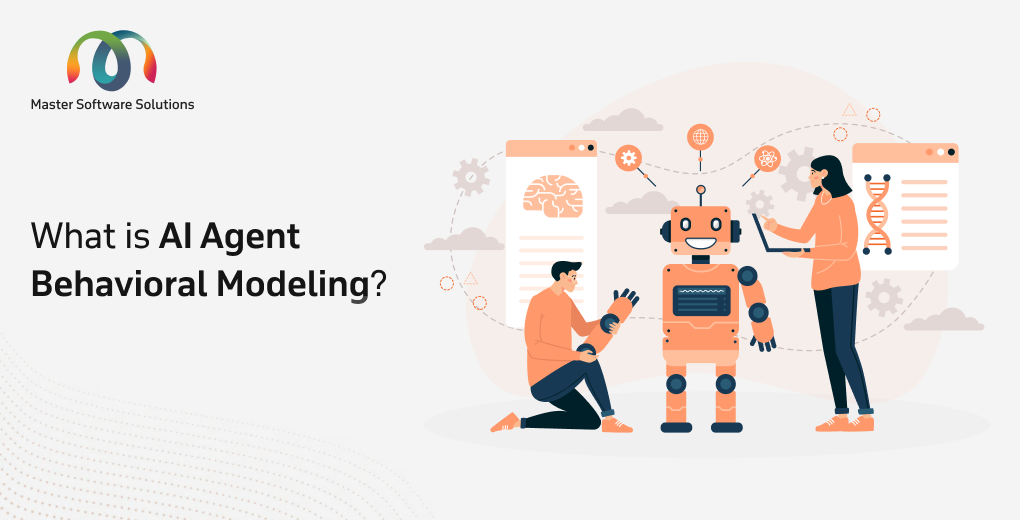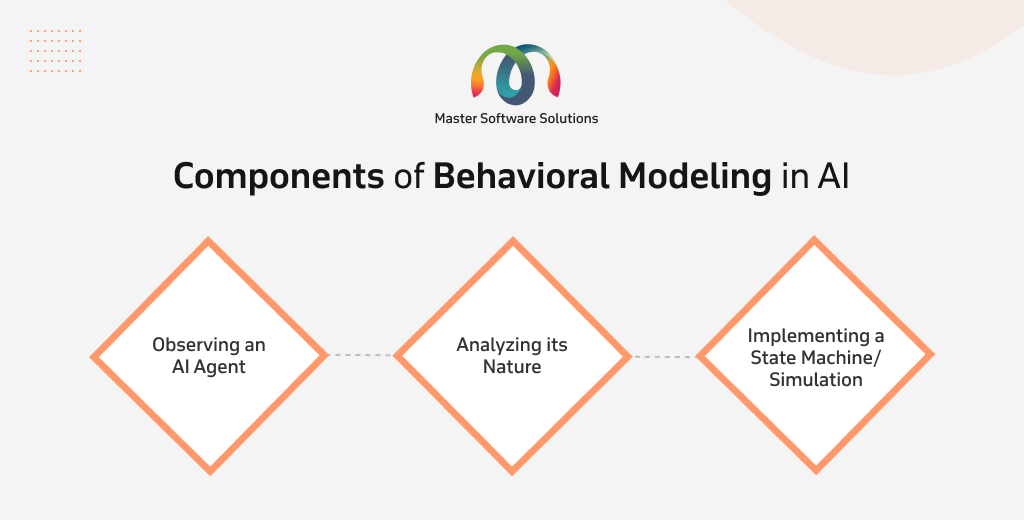AI agents are becoming more persuasive and impactful for driving next-level efficiency. This makes AI agent behavioral modeling crucial. It refers to creating representations (ways that show how AI agents behave) and frameworks (structures that help understand and analyse agents’ behaviour) that describe, predict, and ultimately influence the actions and interactions of the AI agents.
This blog explores the concept of AI agent behavioral modeling, its components, and techniques for effective behavioral modeling.
Understanding the concept of behavior modeling
AI agent behavioral modeling refers to understanding how and why agents act in specific ways. It involves observing, analyzing, and replicating to learn the agent’s mechanism and its causes and effects. The concept of behavioral modeling is applied in various fields, including psychology and social science, and now it is widely used in artificial intelligence.
Components of behavioral modeling in AI
Behavioral modeling of AI agents focuses on understanding how and why agents behave in a certain way, which includes studying behavioral patterns, factors influencing them, and consequences of their actions.
Observing an AI agent
It includes gathering data on how the AI agent behaves in its environment. This process involves data collection, contextual awareness, and passive vs. active observation.
An AI agent’s actions, interactions, and the state of its environment are recorded over time. This data comes in various forms, including:
- Action logs – Record agent’s specific actions.
- State transitions – How the agent’s internal state changes in response to the events.
- Sensor data – Information collected from the agent’s environment.
- Communication logs – Record messages exchanged between other agents or users.
- Performance metrics – Data on how well the agent is achieving its goals.
Understanding the agent’s environmental situation is essential. This involves knowing the agent’s goals, the rules it operates under, other things in the environment, and external factors influencing it.
Observation can be passive (recording what the agent does) or active (introducing specific stimuli to see how the agent responds). Active observation is used to test and extract a particular behavior.
Analyzing its nature
It includes analyzing the observed data to understand the fundamental processes that drive the agent’s behavior. Analyzing an AI agent’s nature includes:
- Identifying internal structures and processes – Examine the agent’s architecture, algorithms, knowledge representation, and decision-making. This involves understanding the agent’s knowledge base, reasoning mechanism, learning algorithms, and goal structures.
- Determine causal relationship – Understand why agents perform specific actions in response to certain stimuli or internal states. This includes statistical analysis, causal inference techniques, or tracing information flow within the agent.
- Characterizing behavioural patterns – Group similar actions or sequences to identify distinct behavioral modes or strategies.
Evaluating performance and efficiency – Analyze how smoothly the agent achieves its defined goals and uses the available resources. - Identify limitations and biases – Explore limitations in the agent’s design or biases in its training data that might lead to unfavourable results.
Implementing a state machine/simulation
It includes creating abstract models or computational environments to represent and study the agent’s behavior. This is done using state machines and simulations.
The state machine is an abstract model that is a computational model for describing different stages an agent can be in and the transitions between those states based on inputs or events. The state machines can be used for:
- Representing behavior – Used to model discrete behaviors or sequences of actions. Each AI agent state represents a specific operational mode or the agent’s decision-making process, and transitions represent how an AI agent transforms from one state to another based on the current situation.
- Analyzing dynamics – State machines can help you visualize and analyze the control flow and possible agents’ behavioral trajectories.
- Designing behavior – They can be used as blueprints to implement desired AI agent behavior.
Simulations refer to creating virtual environments for AI agents to interact, observe, and analyze them under controlled conditions. Simulations include:
- Testing scenarios – Testing agent in a wide range of scenarios, including edge cases or situations that are difficult or dangerous to test in the real world.
- Parameter tuning – Experimenting with AI agents’ different parameters and configurations to see how they behave.
- Evaluating robustness – Assess how well the agent handles uncertainty, noise, and unexpected events.
- Agent-based modeling (ABM) – Invloves multiple interactions between agents, allowing you to study emergent behavior and complex system dynamics.
Techniques for AI agent behavior modeling
There are several techniques for AI agent behavior modeling. You need to understand these techniques to choose the suitable approach for your needs. These techniques include:
Rule-based systems
These systems define AI agent behavior based on a set of predetermined rules. These rules are represented in an IF-THEN format. The IF part specifies that a condition in a rule is met, whereas the THEN part tells about the action the agent should take.
The AI agent evaluates the current situation against the predefined rules in its knowledge base. When the condition is met, the related action is triggered. This process includes sensing, matching rules, and responding.
Machine learning approaches
The machine learning (ML) approach enables an AI agent to learn from data. In this approach, the agent is exposed to multiple desired behaviors or interactions with its environment and learns to make decisions that optimize a specific objective. To do so, various ML algorithms can be used, including:
- Supervised learning – Agents learn a mapping from input (perception) to outputs (action) based on labeled training.
- Unsupervised learning – The agent learns patterns and structures in unlabeled data, which can help understand the environment and its behavior.
- Reinforcement learning – The agent learns through trial and error by interacting with its environment and receiving rewards or penalties for its actions.
- Deep learning – Artificial neural networks with multiple layers are used to learn complex patterns from large datasets, which are often used in perception and decision-making.
Hybrid techniques
These techniques combine the strengths of rule-based systems and machine learning techniques to create robust and versatile AI agents. They aim to use machine learning’s capabilities, such as specific knowledge representation, predictability, and learning capabilities. There are various ways to implement these approaches:
- Using rules to guide learning – Using rules to initialize learning, defining the state or action space, or providing constraints on the learned behavior.
- Using machine learning to learn rules – Machine learning to extract rules from data or refine existing rule sets.
- Combining rule-based and learning modules – The architecture can include separate modules, where specific rules govern some behaviors and others are learned from the data. A higher-level control mechanism decides when to rely on which module.
- Decision making using machine learning for perception and rule-based – Using deep learning to identify objects in the environment (perception) and then use a set of rules to decide how to interact with those objects (decision-making).
Challenges faced in modeling AI agent behavior
AI agent behavior modeling consists of various challenges that can hinder the agent’s progress and effectiveness. The AI agent behavioral modeling challenges include:
Complex behavior design
Designing and developing an AI agent with unique, sophisticated, nuanced, and adaptable behavior is challenging. It becomes more difficult as the number of desirable behaviours grows. One must consider creating comprehensive and manageable models. AI behavior modeling can be time-consuming and resource-intensive, which makes debugging and validating models difficult.
Ethical considerations
AI agents are autonomous entities, which makes ethical considerations essential. They have severe impacts, especially in sensitive sectors like healthcare or automated automobiles. They must align with the ethical guidelines to ensure the agent behaves according to human rights and follows social norms.
Limitations and potential pitfalls
There are certain limitations and potential pitfalls in AI agent behavioral modeling. For instance, the AI agent that overfits in machine learning performs well in training environments but fails in real-world situations. Similarly, poorly trained AI agents result in agents that make wrong predictions and decisions.
Continuous evaluation and refinement of behavioural models is critical for ensuring that the AI agent operates efficiently and is socially responsible.
Hire Master Software Solution for AI agent behavior modeling
Master Software Solutions is an AI agent development company that provides end-to-end development services for AI agents, including AI agent behavioral modeling services. Our team understands behavioral modeling concepts, components, and techniques to build an efficient, ethical, and reliable AI agent. We have built 100+ AI agents that cater to different business departments. Book a call to discuss your AI agent requirements and see how we can help you.


